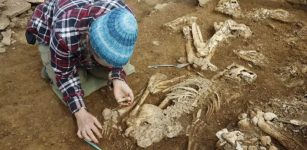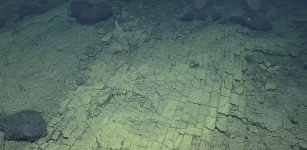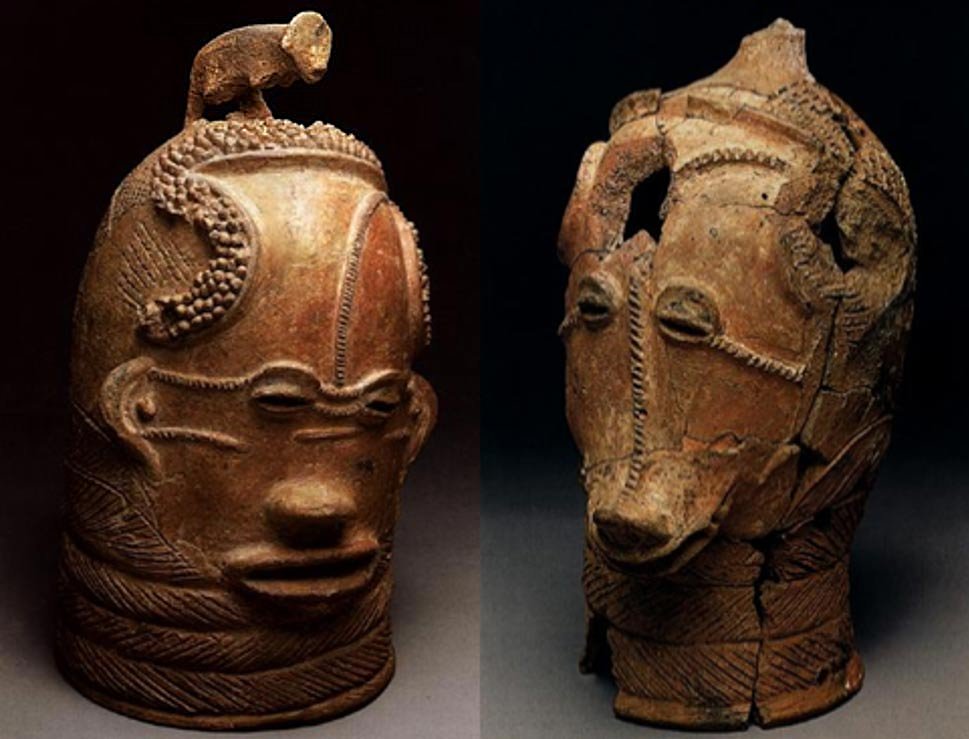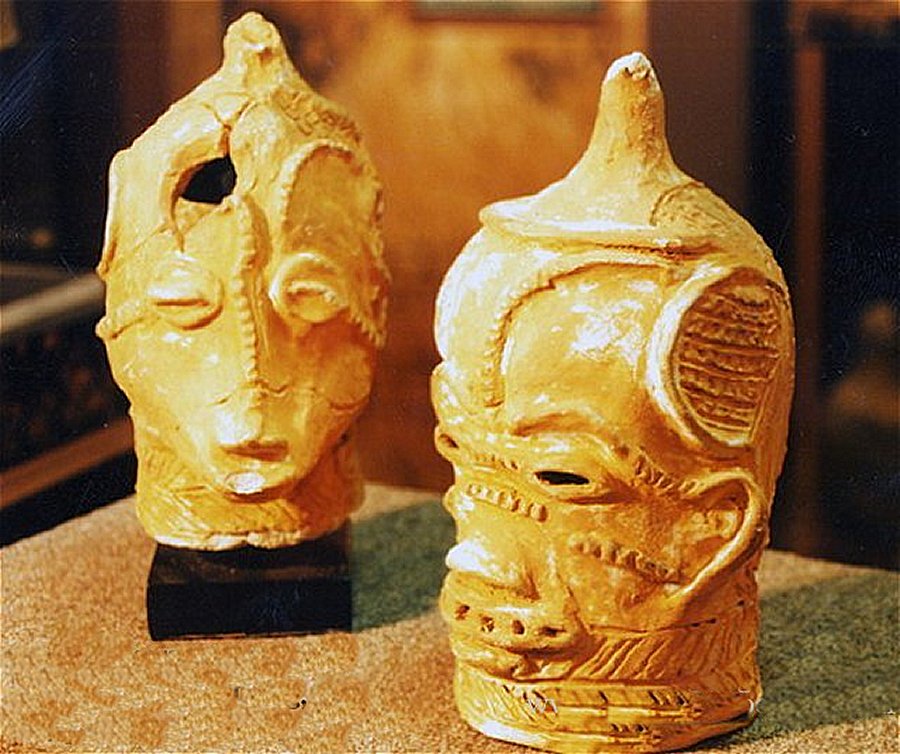Mystery Of The Lydenburg Heads
A. Sutherland - AncientPages.com - In 1957 a young boy, Karl-Ludvig "Ludi" von Bezing (now famous Austrian-South African mineral collector), saw pieces of some mysterious heads while playing in the field on his father's farm, near Lydenburg, Mpumalanga, South Africa.
He returned to the area a few years later and, over a period of several years, collected the pieces of seven heads. This internationally important discovery is known as the Lydenburg Heads.
The artifacts are one of the earliest known forms of African sculpture in Southern Africa. There are seven hollow terracotta sculptures that are named after the site at which they were discovered in the late 1950s.
The heads have scarification marks (scars intentionally created to form patterns on the flesh) on the forehead, temples, and between the eyes. Six of the heads are human and the seventh is some kind of an animal replica.
Nearly life-size terracotta heads are ancient masks officially dated back to 500 AD and represent the earliest and unique sculpture found in southern Africa.
Excavations suggest that the heads may have been burned and deliberately buried, rather than just discarded or abandoned.
The reconstructed heads are not identical but do share a number of characteristics. Modeled strips of clay form the thinly opened oval eyes, slightly projecting mouths, noses, and ears, and raised bands decorating the faces, while the backs of the heads are adorned with incised linear patterns.
The columnar necks are defined by large furrowed rings, Necks ringed with fat have been and continue to be viewed as a sign of prosperity by many African peoples.
However, it is currently impossible to know whether the rings on the Lydenburg heads were intended to be read in this way due to the barely sufficient information available on the ancient culture that produced them.
Nearly life-size terracotta heads are ancient masks officially dated back to 500 AD and represent the earliest and unique sculpture found in southern Africa.
The purpose of the heads is obscure.
Little is known of people who created them but the careful manner, in which they were buried suggests that the masks were of significant value for the people who laid them under the ground.
The heads have scarification marks (scars intentionally created to form patterns on the flesh) on the forehead, temples, and between the eyes. Six of the heads are human and the seventh is some kind of an animal replica.
Of the seven heads, two of them are large enough to be worn as helmets and are surmounted by animal figurines. The other five are decorated with a hole on either side of the neck which was likely used to attach them to a costume or structure.
Animals are a common motif in African mask making. They represent the spirit of an animal and one that bears the mask, becomes that animal himself which allows for communication with that animal, for instance, to ask the animal to keep away from the village. In other cases, the animal is a symbol of virtue.
The most common animals that are represented with masks are buffalo, hyena, hawk, crocodile, and antelope. Antelope is one of the most widely used animal masks, additionally, a small unidentifiable animal sits atop one of the Lydenburg heads.
What kind of role did this unrecognizable animal play for the creators of the Lydenburg Heads? While their actual use continues to be a mystery, archeologists have suggested that they were likely used during initiation rituals as in during the rites of enactment that signified the transition to a new social status or perhaps membership into an exclusive group.
In absence of contemporaneous written documents, the only possibility is to guess at the use and meaning of a head such as this one.
The animals appear only on those Lydenburg heads large enough to have served as helmet masks. The original heads are now housed in the Iziko National Musem in Cape Town and their replicas are displayed in the Lydenburg Museum, Lydenburg, Mpumalanga.
Written by – A. Sutherland AncientPages.com Staff Writer
Copyright © AncientPages.com All rights reserved. This material may not be published, broadcast, rewritten or redistributed in whole or part without the express written permission of AncientPages.com
More From Ancient Pages
-
 Riddle Of Orkney’s Lost Tomb – Fascinating Neolithic Discovery
Featured Stories | Nov 15, 2023
Riddle Of Orkney’s Lost Tomb – Fascinating Neolithic Discovery
Featured Stories | Nov 15, 2023 -
 Has The Burial Place Of Mysterious Dark Age King Cerdic Of Wessex Been Located?
Archaeology | Apr 23, 2024
Has The Burial Place Of Mysterious Dark Age King Cerdic Of Wessex Been Located?
Archaeology | Apr 23, 2024 -
 DNA Sheds Light On Ancient History Of Dogs All The Way To The Ice Age
Archaeology | Oct 30, 2020
DNA Sheds Light On Ancient History Of Dogs All The Way To The Ice Age
Archaeology | Oct 30, 2020 -
 Strange Ancient Underwater Yellow Brick Road Discovered Of The Hawaiian Islands
News | May 11, 2022
Strange Ancient Underwater Yellow Brick Road Discovered Of The Hawaiian Islands
News | May 11, 2022 -
 Coin Hoard Paints A Fascinating Picture Of Life Of Highland Clan Chief And His Household
Archaeology | Oct 13, 2023
Coin Hoard Paints A Fascinating Picture Of Life Of Highland Clan Chief And His Household
Archaeology | Oct 13, 2023 -
 Māori Connections To Antarctica May Go As Far Back As 7th Century
Archaeology | Jun 9, 2021
Māori Connections To Antarctica May Go As Far Back As 7th Century
Archaeology | Jun 9, 2021 -
 Philippine Ayta People Have The Highest Level Of Denisovan DNA – New Study
Archaeology | Aug 12, 2021
Philippine Ayta People Have The Highest Level Of Denisovan DNA – New Study
Archaeology | Aug 12, 2021 -
 2,550 Submerged Wooden Objects Recovered From The Templo Mayor Of Tenochtitlan
Archaeology | Jun 25, 2022
2,550 Submerged Wooden Objects Recovered From The Templo Mayor Of Tenochtitlan
Archaeology | Jun 25, 2022 -
 Dice Existed Long Before Recorded History And Were Not Always Perfect Cubes
Archaeology | Feb 1, 2018
Dice Existed Long Before Recorded History And Were Not Always Perfect Cubes
Archaeology | Feb 1, 2018 -
 Arborglyphs – Basque Immigrant Sheepherders Left Their Marks On Aspen Trees In The American West
Featured Stories | Jul 15, 2024
Arborglyphs – Basque Immigrant Sheepherders Left Their Marks On Aspen Trees In The American West
Featured Stories | Jul 15, 2024 -
 Wonderful Long-Lived Nymphs In Greek And Roman Mythologies
Featured Stories | Mar 29, 2024
Wonderful Long-Lived Nymphs In Greek And Roman Mythologies
Featured Stories | Mar 29, 2024 -
 Hades – Land Of The Dead In Greek Beliefs Offered Punishment And Paradise Full Of Harmony
Featured Stories | Aug 15, 2019
Hades – Land Of The Dead In Greek Beliefs Offered Punishment And Paradise Full Of Harmony
Featured Stories | Aug 15, 2019 -
 Pyramid Of The Moon At Teotihuacán – Underground Tunnel And Chamber Found
Archaeology | Oct 29, 2018
Pyramid Of The Moon At Teotihuacán – Underground Tunnel And Chamber Found
Archaeology | Oct 29, 2018 -
 Well-Preserved Settlement Dated To 2,400 BC Unearthed At Tell Edfu, Egypt
Archaeology | Feb 8, 2018
Well-Preserved Settlement Dated To 2,400 BC Unearthed At Tell Edfu, Egypt
Archaeology | Feb 8, 2018 -
 Trolls – Fascinating Mythical Creatures Of Scandinavia
Featured Stories | Jun 13, 2022
Trolls – Fascinating Mythical Creatures Of Scandinavia
Featured Stories | Jun 13, 2022 -
 Greek God Asclepius And Ancient Healing Center ‘Asclepion Of Pergamum’
Civilizations | Nov 29, 2014
Greek God Asclepius And Ancient Healing Center ‘Asclepion Of Pergamum’
Civilizations | Nov 29, 2014 -
 Has A 12,000-Year-Old Underwater City Been Discovered Off The Coast Of Louisiana?
Archaeology | Mar 9, 2022
Has A 12,000-Year-Old Underwater City Been Discovered Off The Coast Of Louisiana?
Archaeology | Mar 9, 2022 -
 7,000-Year-Old Underwater Road Discovered In Adriatic Sea Off Korcula Island
Archaeology | May 11, 2023
7,000-Year-Old Underwater Road Discovered In Adriatic Sea Off Korcula Island
Archaeology | May 11, 2023 -
 What Caused The Year Without A Summer In 1816?
Ancient History Facts | Sep 17, 2018
What Caused The Year Without A Summer In 1816?
Ancient History Facts | Sep 17, 2018 -
 DNA Reveals Participants In California’s Gold Rush Dined On Salted Atlantic Cod
Archaeology | Jan 7, 2022
DNA Reveals Participants In California’s Gold Rush Dined On Salted Atlantic Cod
Archaeology | Jan 7, 2022


